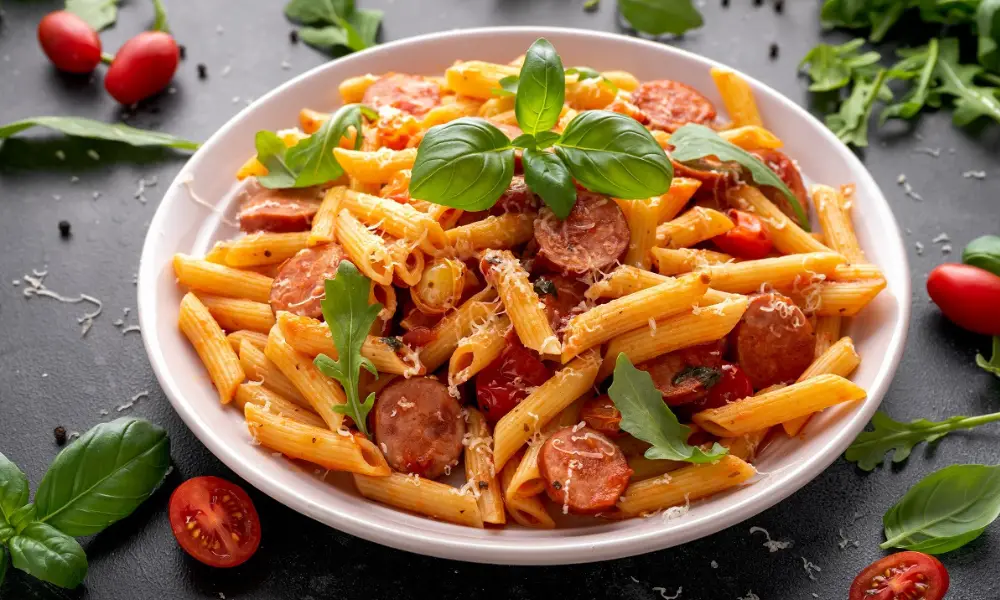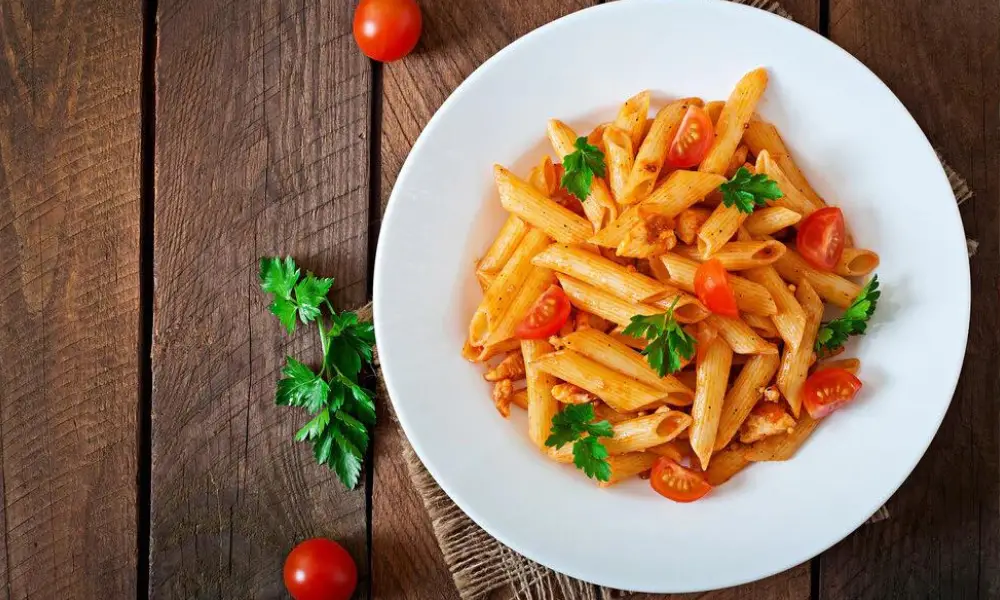Inconsistent pasta might result from microwave reheating, and it can dry out, get clumpy and mushy, have hot lava patches next to cold spots, etc. A microwaved pasta container is rarely as tasty as the day it was freshly cooked.

However, not all is lost! It is feasible to successfully reheat cooked pasta so that it tastes nice and you look forward to eating it.
What is Pasta?
Pasta is often produced with durum wheat, water, or eggs. It is then boiled in boiling water after being shaped into various noodle shapes.
Nowadays, ordinary wheat is used to make the majority of pasta-related goods. However, other grains like rice, barley, or buckwheat can also be used to make comparable noodles.
Some pasta varieties undergo refinement during processing, removing the bran and germ from the wheat kernel and many nutrients.
Enriched pasta has some minerals added back in, like B vitamins and iron. There is also whole-grain pasta on the market, including the wheat kernel.
Here are a few instances of pasta varieties that are frequently consumed:
- Spaghetti
- Tortellini
- Ravioli
- Penne
- Fettuccine
- Orzo
Pasta frequently has meat, sauce, cheese, veggies, and herbs as toppings.
How to Reheat Cooked Pasta?
Four Ways to Reheat Leftover Pasta can Result in Delectable Dishes
Boil it
If you keep your pasta and sauce apart, this works. The first time you make pasta, portion out what you will eat for that dinner and then run the remaining sauce spaghetti under cold water to halt the cooking and keep it from becoming mushy.
When it’s time to reheat your pasta, boil a pot of water, submerge the noodles for 30 to 60 seconds, drain, and then immediately add the pasta and chilled sauce to the boiling pot to combine and heat the sauce.
If you’re bringing pasta and sauce to work, boil the water first (carefully) in a kettle or even the microwave before pouring it over the pasta in a container or big bowl. Wait for 30 to 60 seconds before draining. In this situation, you should warm up your sauce in the microwave for an additional 30 to 60 seconds before topping your pasta.
Soup it
As the baked cheese tastes so excellent in a soup, this is a genuinely original and filling way to use leftover baked pasta like lasagna or cannelloni. Make bite-sized pieces of your cold lasagna (or other baked pasta). Simmer some chicken or veggie broth in a pot.
Pasta should be added, thoroughly mixed, and simmered for one or two more minutes to reheat. The best comfort food for chilly weather is the cheesy chunks and tender spaghetti bits!
If you’re making this at work, bring your soup broth in a separate microwave-safe container, and your pasta is already cut into chunks. After stirring the spaghetti chunks for 30 to 60 seconds, zap them once more for 30 to 60 seconds. The broth should then be heated almost to a simmer. In a bowl or other container, combine the pasta with the broth and toss thoroughly. The hot broth will keep the pasta warm if you microwaved it and it wasn’t heated all through.
Steam it
In a low skillet with a tight-fitting lid, heat a few tablespoons of water to a simmer before adding pasta with sauce. Place the cover on after adding the pasta. After about 30 seconds, open the cover, give it a swirl, and then replace the lid. Continue until the desired temperature is reached.
Continuous stirring guarantees even heating and prevents the formation of any mushy, overdone portions. Your food won’t dry out since the steam from the little bit of water will rehydrate the sauce and noodles.
If you’re careful, this technique might work nicely in a microwave at the office. Pasta leftovers should be placed in a bowl or container that can be heated in a microwave. Zap for 30 to 60 seconds, remove, stir thoroughly, and repeat until everything is thoroughly heated. Your pasta will come to life and be heated more evenly thanks to the steam from the water. You can prevent it from becoming a gluey mess by stirring frequently.
Bake it
This way works best if you prefer a little bit of noodle crispness. Evenly distribute your leftovers on a baking sheet and bake for 15 to 20 minutes at 350 degrees, turning once halfway through. You’ll get great crispy bites of toasted deliciousness and evenly heated spaghetti.
It would help if you lined the tray with parchment paper, a reusable silicone liner, or very gently oil a non-stick baking pan before adding pasta because pasta heated in this manner tends to adhere to the surface.
If your workplace has a toaster oven, you can perform this in tiny quantities on the toaster oven tray even if it won’t work in the company microwave. Just remember to carry a piece of foil to cover the tray so you won’t be leaving stuck-on pasta bits on it forever, out of consideration for your coworkers.
Name Some Different Types of Pasta
Spaghetti
Spaghetti is a long, thin pasta dish that may be coupled with various sauces, making it one of the most popular pasta varieties worldwide. The plate with the most recognition is undoubtedly spaghetti bolognese, which combines pasta and meat in a marinara sauce. Any meat and vegetable dish, or even just garlic and olive oil, goes well with this pasta.
Penne
Another familiar shape is the penne, which has a circular, tube-like structure with diagonal incisions on either end. It enters the tube and holds the sauce nicely, which works best in meals with a relatively thick, creamy sauce like Penne Arrabbiata. The best pasta to use in spaghetti-baked meals is also this kind.
Lasagne
Contrary to popular belief, a meal’s tiny pasta sheets are known as lasagne rather than the actual dish. The most popular oven-baked version, lasagne al Forno, presumably consists of a beef or pork ragu sandwiched between layers of lasagne and béchamel sauce, topped with cheese. Lasagne is used in other oven-baked dishes as well. You can change the filling of this recipe to be anything you wish, such as substituting mushrooms for the meat.
Farfalle
This pasta is fashioned perfectly like a butterfly and is referred to as “bow-tie” spaghetti in English. Since of its compact size and high surface area, this pasta goes well with a cheese sauce or a hearty tomato sauce because the ‘wings’ perfectly hold the sauce. Additionally, it goes well with a cold pasta salad and is occasionally served with grilled chicken.
Would Whole-Grain Pasta be a Better Choice?
The entire wheat kernel is used to make whole grains. Compared to refined grains, which solely retain the endosperm of the wheat kernel, they have higher fiber content, vitamins, and minerals.
Lower risk of heart disease, colon cancer, diabetes, and obesity has been linked to eating whole grains. But remember, whole-grain pasta is prepared from whole-wheat flour that has been ground.
Since smaller grains digest more quickly and cause more significant spikes in blood sugar, this process lessens the health benefits of the whole grains contained in pasta.
As a result, the advantages of intact whole grains, like oats, brown rice, or quinoa, are not comparable to those of whole grains used to make pasta.
Although there isn’t much difference in the benefits of whole-grain and refined portions of pasta on health, whole-grain pasta might be a better option if you’re trying to reduce weight. Compared to delicate pasta, it has fewer calories and more fiber, which increases satiety.
Except for B vitamins, which are put back into enriched pasta during processing, whole-grain pasta also has higher concentrations of most micronutrients.
How to Make Pasta Healthier?
Pasta is a food that, in moderation, can be a component of a balanced diet. Given that it contains more fiber and minerals while having fewer calories and carbs, whole-grain pasta may be a superior option for many people.
But what you top the spaghetti with is just as significant as the pasta you choose. Calories may mount up quickly when adding high-fat, high-calorie toppings like cream-based sauces and cheeses. If you are monitoring your weight, substitute some of your favorite vegetables, fresh herbs, or a drizzle of heart-healthy olive oil.
You can also add your preferred protein to make pasta a balanced meal. While broccoli, bell peppers, or tomatoes might offer nutrients and extra fiber, fish and chicken can contribute a little extra protein to keep you feeling full and content.
Other suggestions for nutritious pasta recipes are as follows:
- spaghetti made with whole wheat, lemon, basil, and salmon
- Baked Ziti with vegetables
- Kale, tomatoes, feta, and olives in a pasta salad
- Chicken and spinach avocado sauce on rotini.
Which Kind of Pasta is Mostly Consumed?
The Most Popular Pasta to Consume iss Refined.
Most people prefer refined pasta, stripped of the wheat kernel’s germ and bran and many of its nutritional components.
Refined pasta has fewer fiber and more calories. As a result, compared to eating high-fiber, whole-grain pasta, you could feel less satisfied after eating it.
According to one study, whole-grain pasta increased feelings of fullness and reduced appetite more than refined spaghetti.
However, additional research on the advantages of whole-grain pasta has produced contradictory findings. There was no difference in blood sugar levels after consuming refined pasta or whole-grain pasta, according to research with 16 participants.
Nevertheless, several studies have revealed that consuming a lot of refined carbohydrates may harm your health.
For instance, a study involving 117,366 individuals discovered a relationship between excessive carb intake, particularly refined grains, and an elevated risk of heart disease.
Increased consumption of refined grains was linked to worsened blood pressure, blood sugar, lousy LDL cholesterol, blood triglycerides, and insulin resistance, according to another study of 2,042 adults. However, more research on the specific health impacts of refined pasta is required.
Additionally, it should be noted that pasta has a low to the medium glycemic index, which is lower than that of many other processed foods.
Why Should We Eat More Pasta?
As Part of a Healthy Diet
The grain used to make pasta is one of the fundamental food groups in a balanced diet, along with vegetables, fruits, fish, and fowl. If it’s prepared from whole grains, it can provide you with fiber in addition to being a healthy source of energy. That may decrease cholesterol and aid with gastrointestinal issues. Try some tagliatelle with truffle oil and wild mushrooms.
It Reduces Your ‘Hunger’
It might prevent your craving for meals for a considerable amount of time because it is filling. You won’t be as prone to become irritable, unpleasant, or “hangry.” Try orecchiette, a circular pasta with sausage and broccoli rabe, for a classic Italian dish with a kick of red chile.
It’s Inexpensive
Flour, water, salt, and sometimes some eggs are the only necessary and inexpensive ingredients. Pasta is a fantastic way to feed the family cheaply, whether you prepare it yourself or buy it at the supermarket. Consider trying a classic spaghetti Bolognese, where the meat is simmered in milk and wine.
Conclusion
If you’ve been eating leftover pasta, you’ve probably wondered how to reheat cooked pasta. Pasta can be spoilt by touch, smell, and taste. Although you don’t want to eat the whole spoonful, you want to ensure that it doesn’t taste sour or rubbery. Proper reheating can make pasta taste like freshly made pasta without losing its fresh flavor. The methods for reheating pasta will differ depending on what pasta you’ve purchased and prepared.

